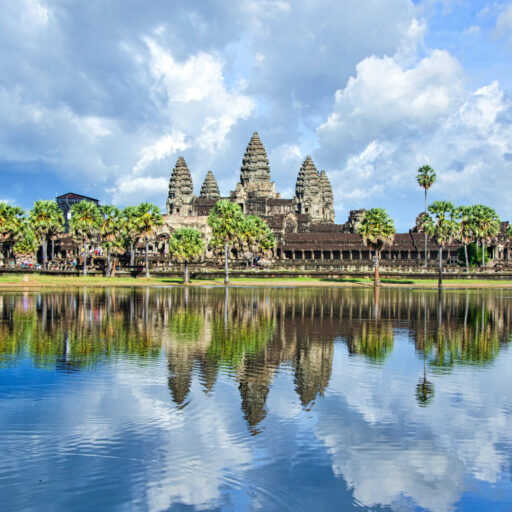
Nestled in the center of Angkor Thom in Cambodia, Bayon Temple stands as one of the most iconic and enigmatic monuments of the ancient Khmer Empire. Known for its towering stone faces and intricate bas-reliefs, Bayon represents the spiritual and political core of King Jayavarman VII’s grand vision for his capital.
A Monument to Mahayana Buddhism
Constructed in the late 12th to early 13th century, Bayon was commissioned by King Jayavarman VII, a devout follower of Mahayana Buddhism. Unlike earlier Angkorian temples dedicated primarily to Hindu gods, Bayon was built as a Buddhist shrine, reflecting the shift in religious orientation during his reign.
At the heart of Bayon is a central sanctuary symbolizing Mount Meru, the cosmic center in Hindu-Buddhist cosmology. Surrounding it are 54 towers, many adorned with the temple’s most iconic feature: the giant stone faces.

The Mysterious Smiling Faces
One of Bayon’s most captivating characteristics is the serene and smiling stone faces that adorn many of its towers. There are over 200 faces, believed by scholars to represent either the bodhisattva Avalokiteshvara or perhaps a deified version of King Jayavarman VII himself.
The faces exhibit a sense of calmness and introspection, which has earned them the nickname “The Mona Lisa of Southeast Asia.” Their enigmatic expression continues to inspire awe and intrigue among visitors and historians alike.

Stories Carved in Stone
Bayon’s outer galleries are lined with extensive bas-reliefs that depict vivid scenes of 12th-century Cambodian life, from market scenes and festivals to military battles and historical events. These carvings serve not only as artistic masterpieces but also as a visual archive of the culture, beliefs, and daily life of the Khmer Empire.
One notable panel shows the historic naval battle between the Khmers and the Chams, providing both drama and detail in its stone storytelling.
Architectural Marvel and Spiritual Symbol
Unlike the linear, symmetrical designs of earlier Angkor temples, Bayon’s layout is intentionally complex and layered, reflecting both Buddhist cosmology and the shifting religious climate of the time. The temple’s layout creates a symbolic journey from the earthly realm to the divine.
Despite centuries of erosion and restoration, Bayon retains much of its original majesty. Conservation efforts led by both Cambodian and international teams continue to preserve its structure and artistry for future generations.
Visiting Bayon Temple Today
Bayon is located within the larger Angkor Archaeological Park, just north of Siem Reap. It is easily accessible and is often included in tours of Angkor Wat and surrounding temples. The best times to visit are early morning or late afternoon, when the sunlight casts dramatic shadows on the stone faces and the temple is less crowded.
For photographers, history buffs, and spiritual seekers, Bayon offers a uniquely intimate experience—an invitation to step back in time and explore the sacred heart of a once-great empire.
Plan Your Visit:
- Location: Angkor Thom, Siem Reap, Cambodia
- Entrance Fee: Included with Angkor Pass
- Opening Hours: 5:00 AM – 6:00 PM
- Best Time to Visit: November to February (cooler, drier months)
Whether you’re drawn by its haunting beauty, historical significance, or spiritual symbolism, Bayon Temple remains a must-see marvel—one that continues to whisper stories of a bygone age through its silent stone faces.

Leave a Reply